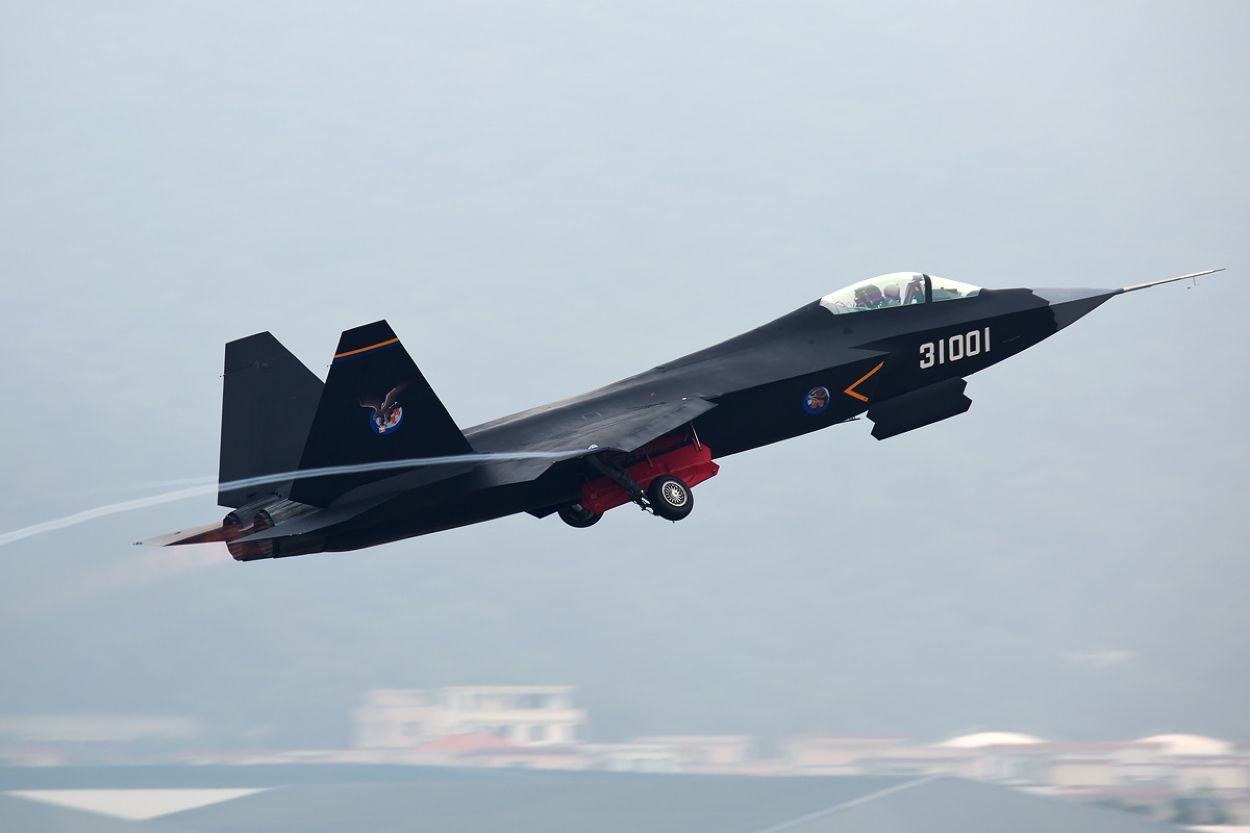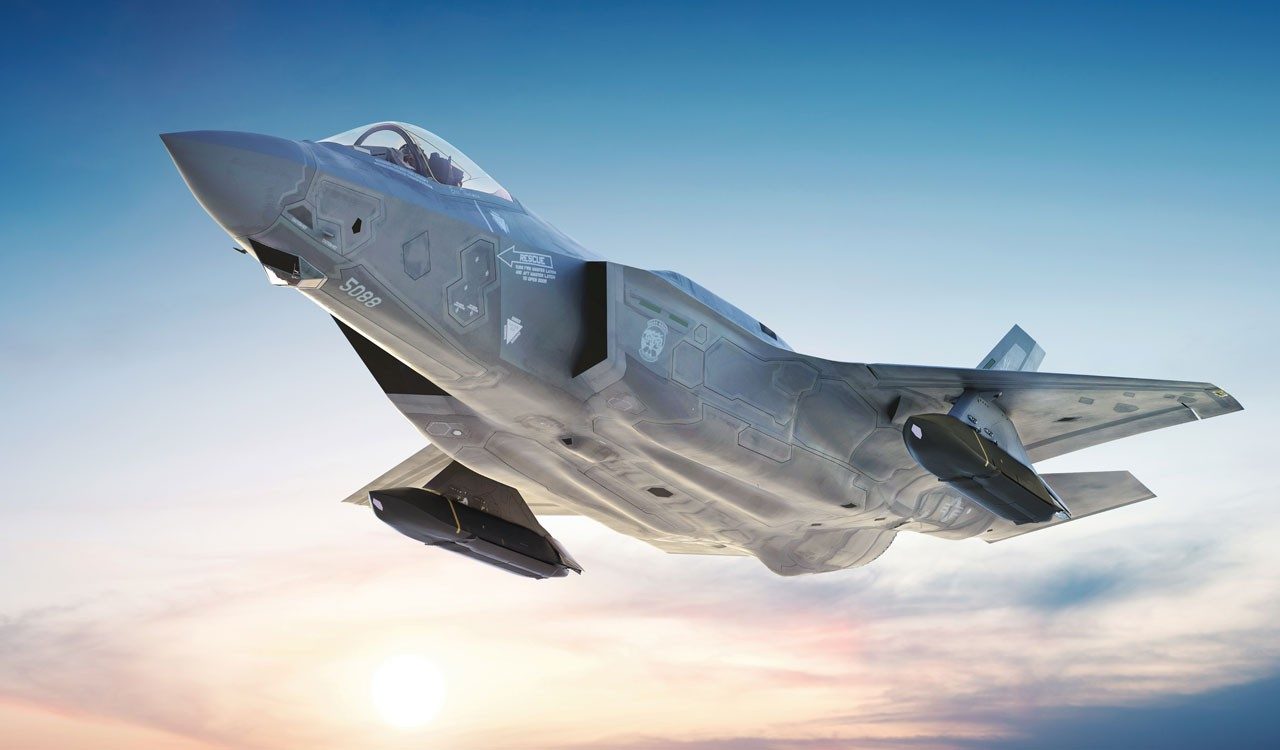On July 8, Chinese state broadcaster CCTV released a promotional video of China’s J-31B stealth fighter jet, produced by the state-owned Shenyang Aircraft Corporation.
The footage suggests that the aircraft can carry two missiles in its side weapon bays—a feature that differentiates it from the USA’s F-22 and China’s own J-20. Moreover, the main weapons bay can carry four PL-12 medium-range air-to-air missiles similar to those used on the J-20.
Fu Qianshao, a defense analyst with extensive experience based in Beijing, believes that the fighter jet is fully prepared for deployment. Speaking to the South China Morning Post, he said, “The transformation of the FC-31 into J-31 indicates that it has met the formal requirements for military service and has received an official designation.”
Why Did Netizens ‘Mock’ Nigeria For Importing JF-17 Thunder Fighter Aircraft From China & Pakistan?
Originally marketed as the FC-31 for international sales, the jet is now referred to as the JF-31 or JF-35 by Chinese experts, though the plane has no official designated name. It is being marketed as similar to the American F-35 Lightning II.
The latest prototype looks slightly bigger than the original FC-31, which was unveiled a decade ago. The report also stated that the warplane completed its maiden flight in 2012 and was publicly unveiled at the 2014 Zhuhai Air Show. Xinhua News reported in 2015 that the aircraft had the potential to enhance the capabilities of the J-20 in aerial combat and could also operate alongside the J-15 on aircraft carriers.
In recent years, the aircraft has generated a lot of buzz, primarily because it is an aircraft carrier-based plane. There is speculation that the fighter jet will be used on China’s third and most advanced aircraft carrier, Fujian, equipped with electromagnetic catapult systems.
The first two fighter jet prototypes since their introduction in 2012 were based on a land-based aircraft. Over time, interest in the land-based version of the plane declined, shifting the focus to the carrier-based version. Despite this, Shenyang Aircraft Corporation reconsidering the land-based variant due to interest from potential foreign buyers like Pakistan.
China had displayed a model of the FC-31 at the Saudi Air Show in January. In the same month, Pakistan’s Air Chief Marshal Zaheer Abbas Baber Sidhu announced plans to purchase the plane.
He said, “The foundation for acquiring the J-31 stealth fighter aircraft has already been laid which is all set to become part of the PAF’s fleet in the near future.”
An image shared by Chinese aviation researcher @Rupprecht_A on May 29, 2024, confirmed the development. As reported by the EurAsian Times last month, the image seemed to confirm the development of a land-based type of the plane.
Back from vacation means back at work! 😆
Any news I missed concerning the question of "J-31 or not?" since my return from France?🤔
I found these three & added the J-35 on my own, even if indeed not the same angle like the other three, it looks at least "different" to a J-35! pic.twitter.com/x1IRMOhyqv
— @Rupprecht_A (@RupprechtDeino) May 29, 2024
Compared to the carrier-based version, the J-31 featured a larger surface area with a small gap where the horizontal tail surfaces intersect with the wing. The land version also has a twin-wheel set-up instead of the single-nose wheel arrangement on the carrier-based plane. It also lacked the catapult launch bar, a norm on planes aboard an aircraft carrier.
China is promoting the sale of fighter jets to Pakistan and the Middle East, as demonstrated by the plane’s presence at the Saudi Air Show.
The UAE’s interest in the jet fighter stems from a previous deal for 50 F-35s signed during former US President Donald Trump’s presidency. The agreement was halted in 2021 after President Joe Biden took office. This was primarily due to worries about technology secrets being shared with China — a consequence of the close relationship between the two nations.
The risk of technology leaks has been taken very seriously by the US after several experts pointed out the resemblance between the F-22s, the F-35s, and the Chinese J-31. The J-31’s flat tail and twin engine seem to be derived from the F-22, while the front end resembles that of the F-35.
In 2014, the “U.S.-China Economic and Security Review Commission” Congressional report cited a Defense Science Board finding that Chinese cyber-attacks had siphoned off crucial technical aspects of several US weapons systems, including the F-35.
China has prohibited the export of the J-20 aircraft, similar to how the USA has restricted the sale of the F-22. Thus, the push to create a ground version of the J-31 can be seen as China’s effort to enter the lucrative fifth-generation fighter jet market that is currently dominated by the US.
Questions have been raised about the aircraft’s design and features, as it is still in its initial stage. The stealth elements are the forward-swept intake ramps with Diverterless Supersonic Inlet (DSI) bumps, a two-piece bubble canopy, curved weapon bays, and two oblique vertical stabilizers. Composite materials make up a significant part of the fuselage.
Officials from the Aviation Industry Corporation of China (AVIC) have stated that the aircraft is undetectable by L-band and Ku-band radars and can evade other sensors.

The aircraft is being readied for super-cruise capability. The prototype aircraft’s engines were RD-93 engines similar to the ones on Pakistan’s JF-17 made by Russian manufacturer Klimov. Later, China shifted to the improved variant of the Guizhou WS-13, also known as WS-13E, with a 100kN thrust.
The latest information suggests that the warplane could have the WS-19 engine, which will provide a maximum thrust of 12 tons, an increase from the base WS-13 thrust of 9 tons.
Pakistan, India 5th-Gen Fighter Race
Pakistan could become the first export customer of China’s stealth fighters. The country already operates JF-17 Thunder and J-10C fighters. The J-10s have been pitched as a counterweight to India’s Rafale fighters, but many experts say Dassault fighters are far superior to anything that Pakistan and even China operate.

With clear indications that Pakistan is likely to acquire China’s very own “F-35 stealth fighters,” pressure is building in India to accelerate its modernization drive.
Pakistan acquiring a fifth-gen fighter, with no equivalent in the IAF, would give it a tactical advantage over Indian jets. Pakistan’s close military links with China would ensure that the PAF can acquire and induct advanced fighters at a far quicker rate than India. An expert said the IAF needs to address its long-standing challenges of declining squadron strength and repeated delays in acquiring new ones.
Nitin J Ticku, Managing Editor of EurAsian Times and an aviation expert, believes that if India is serious about acquiring a fifth-gen fighter, then the only option India has is the F-35. India has AMCA, but it will not be operational for 10 years, and IAF would not want to invest in Russia’s Su-57 program again after pulling out in 2018.
IAF officials have repeatedly praised the Rafale fighters. If India wants to catch up with China, it needs a superior aircraft. Even France is developing a next-gen fighter, and it’s time India gets one, too.
The US is keen to get into India’s fighter jet ecosystem and has offered F-15EX and F-21 fighters to India. F-35 is officially not on the table but can be offered, as we understand. F-35 stealth fighters are a great option. The only issue with US fifth-gen warplanes is that they would seriously challenge India’s strategic autonomy and neutral stance New Delhi has been undertaking. The biggest question is, Is India ready for the F-35 gamble?
- By: ET Digital Desk
- Follow EurAsian Times on Google News




